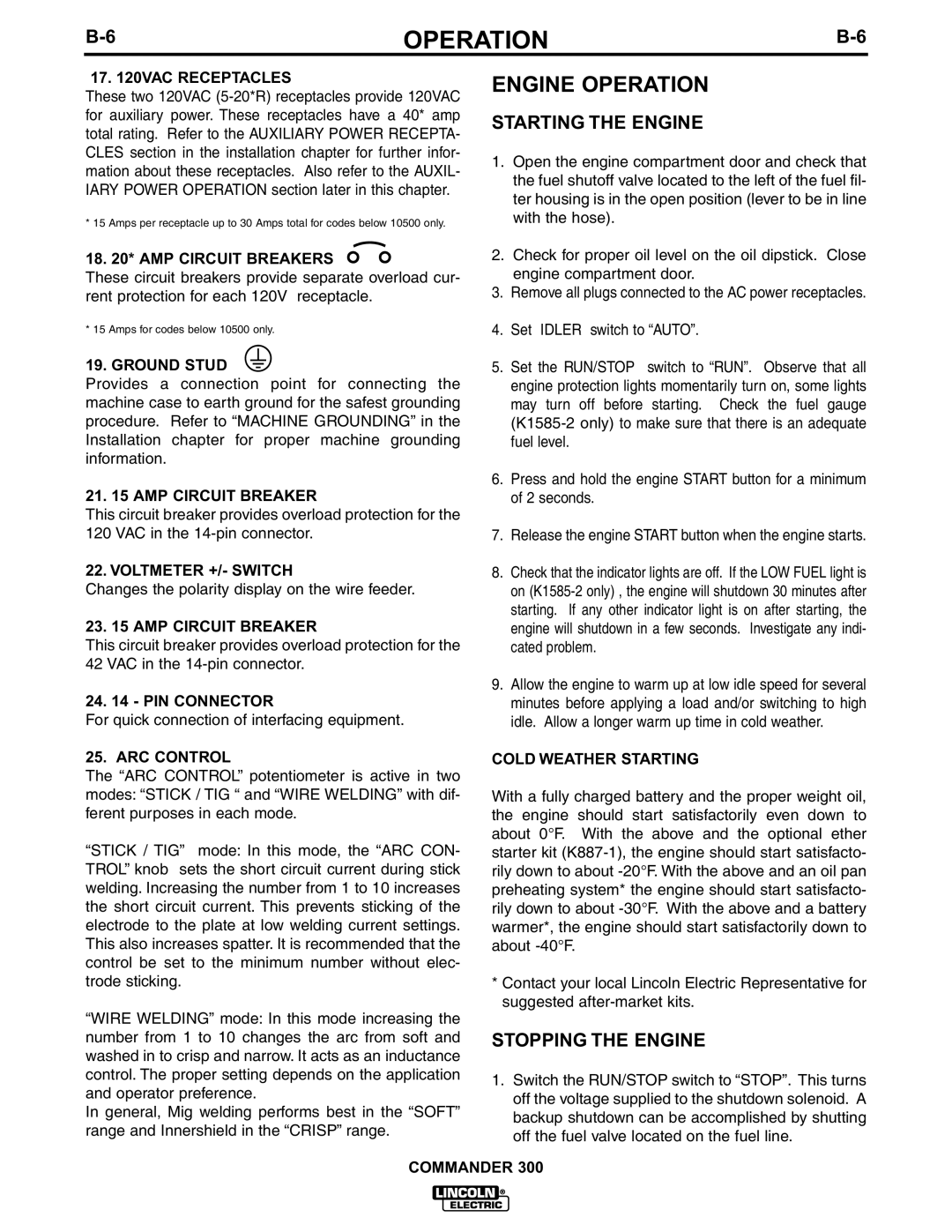
OPERATION | ||
|
|
|
17. 120VAC RECEPTACLES
These two 120VAC
* 15 Amps per receptacle up to 30 Amps total for codes below 10500 only.
18. 20* AMP CIRCUIT BREAKERS
These circuit breakers provide separate overload cur- rent protection for each 120V receptacle.
* 15 Amps for codes below 10500 only.
19. GROUND STUD
Provides a connection point for connecting the machine case to earth ground for the safest grounding procedure. Refer to “MACHINE GROUNDING” in the Installation chapter for proper machine grounding information.
21. 15 AMP CIRCUIT BREAKER
This circuit breaker provides overload protection for the 120 VAC in the
22. VOLTMETER +/- SWITCH
Changes the polarity display on the wire feeder.
23. 15 AMP CIRCUIT BREAKER
This circuit breaker provides overload protection for the 42 VAC in the
24. 14 - PIN CONNECTOR
For quick connection of interfacing equipment.
25. ARC CONTROL
The “ARC CONTROL” potentiometer is active in two modes: “STICK / TIG “ and “WIRE WELDING” with dif- ferent purposes in each mode.
“STICK / TIG” mode: In this mode, the “ARC CON- TROL” knob sets the short circuit current during stick welding. Increasing the number from 1 to 10 increases the short circuit current. This prevents sticking of the electrode to the plate at low welding current settings. This also increases spatter. It is recommended that the control be set to the minimum number without elec- trode sticking.
“WIRE WELDING” mode: In this mode increasing the number from 1 to 10 changes the arc from soft and washed in to crisp and narrow. It acts as an inductance control. The proper setting depends on the application and operator preference.
In general, Mig welding performs best in the “SOFT” range and Innershield in the “CRISP” range.
ENGINE OPERATION
STARTING THE ENGINE
1.Open the engine compartment door and check that the fuel shutoff valve located to the left of the fuel fil- ter housing is in the open position (lever to be in line with the hose).
2.Check for proper oil level on the oil dipstick. Close engine compartment door.
3.Remove all plugs connected to the AC power receptacles.
4.Set IDLER switch to “AUTO”.
5.Set the RUN/STOP switch to “RUN”. Observe that all engine protection lights momentarily turn on, some lights may turn off before starting. Check the fuel gauge
6.Press and hold the engine START button for a minimum of 2 seconds.
7.Release the engine START button when the engine starts.
8.Check that the indicator lights are off. If the LOW FUEL light is on
9.Allow the engine to warm up at low idle speed for several minutes before applying a load and/or switching to high idle. Allow a longer warm up time in cold weather.
COLD WEATHER STARTING
With a fully charged battery and the proper weight oil, the engine should start satisfactorily even down to about 0°F. With the above and the optional ether starter kit
*Contact your local Lincoln Electric Representative for suggested
STOPPING THE ENGINE
1.Switch the RUN/STOP switch to “STOP”. This turns off the voltage supplied to the shutdown solenoid. A backup shutdown can be accomplished by shutting off the fuel valve located on the fuel line.
